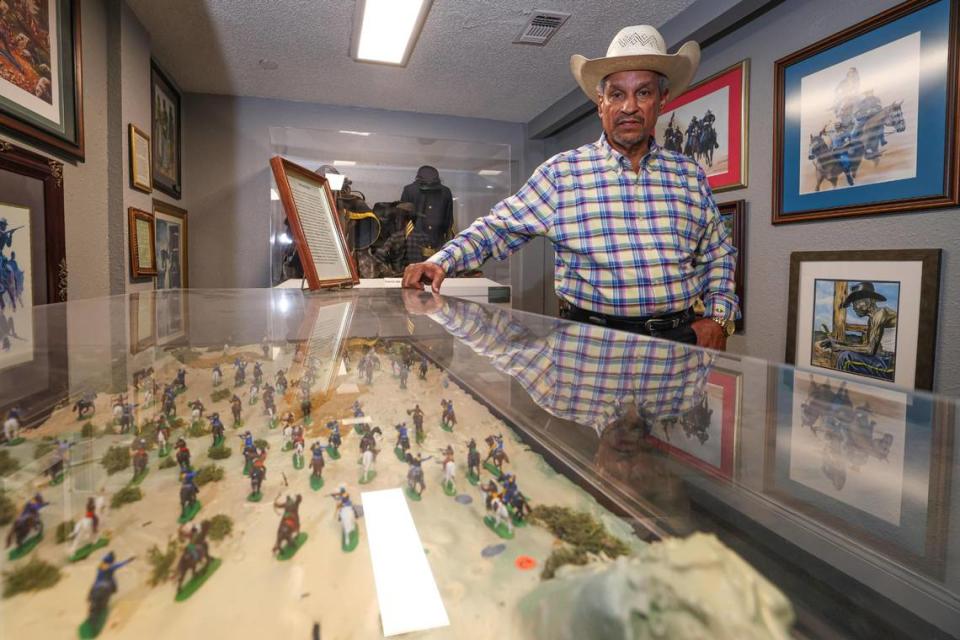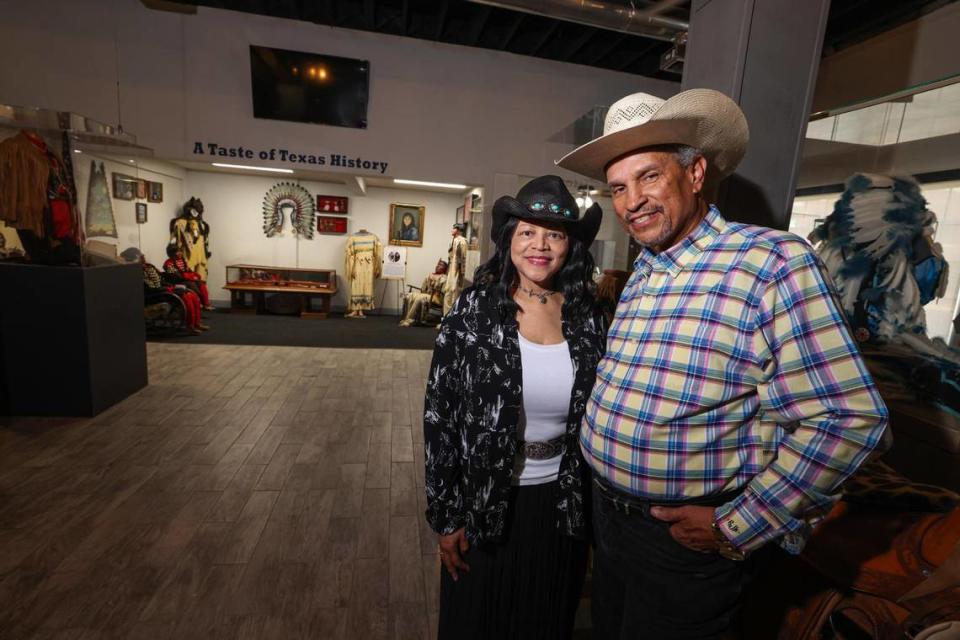Forgotten cowboys: The cost of rent is forcing a major decision on this Fort Worth museum
- Oops!Something went wrong.Please try again later.
The National Multicultural Western Heritage Museum is on the corner of North Main Street and West 21st Street, just a few blocks from the Stockyards, the anchor of Fort Worth’s cowboy culture.
Jim and Gloria Austin are the owners of the museum, where 95% of the items have been donated from people’s attics, garages and stores or were found by someone sifting through the junk inside a barn.
Pictures taken from the late 19th to early 20th centuries line the front wall inside the museum. Black, Indigenous, and Hispanic men and women with their Stetson hats, long sleeve shirts, pants, and boots stand on weedy, dusty land and stare into the camera. Viewers get a glimpse into the lives of the cowboys who were the original workers in the cattle industry.
Every exhibit is dedicated to the diversity of the men and women who helped leave a footprint in the early settling of the American West.
But the Austins say they museum is in danger of leaving its home due to the cost of rent. They want to preserve the museum, its artifacts and the heritage and stories of the people it portrays.
“These are real life heroes we represent,” Jim Austin said.
Currently, the Austins pay $8,600 a month for rent. They need to generate more income to cover the rent, find a new building, or shrink the museum to a point where most of the exhibits will be virtual. They generate a majority of their operating funds through a Martin Luther King Jr. celebration every January and their Hall of Fame Induction ceremony every July. Supporters can go to their website to donate, and a crowdfunding effort will begin soon.
They are looking for a location with at least 2,000 square feet of space.
Multicultural frontier
Historian Art Burton describes the frontier as the edge of civilization, where people try to survive against the elements of nature.
After the Indian Removal Act of 1830 forced the removal of Indigenous tribes to lands west of the Mississippi River, the Cherokee, Choctaw, Chickasaw, Creek, and Seminole tribes settled in what was then called Indian Territory. The territory was mainly Oklahoma but also encompassed areas of Kansas, Nebraska, and part of Iowa.
Those tribes had embraced slavery when they were moved to the Indian Territory and took their slaves with them. Eventually, there was a close relationship between African slaves and Indigenous tribes as some slaves gained their freedom and others intermarried with members of Indigenous tribes.
The African slaves began to speak in the tribes’ languages and lived in their culture. They were eventually called Indian freedmen, who would be interpreters between the tribes and the U.S. government.
After the Civil War, Black and Indigenous people worked in the cattle industry as cowboys. They rode together as lawmen, and even as outlaws in the Indian Territory, according to Burton.
Many Indigenous Americans embrace Western culture and the rodeo, working as ranchers and cowboys. Many Mexican Americans had similar experiences and were the source of cowboy boots and other equipment they used while ranching and handling horses and cattle in Mexico and Texas.
African Americans, Indigenous Americans and Mexican Americans played a major role in creating the western heritage as we know it today, Burton said.
The museum holds multiple rooms dedicated to groups such as Buffalo Soldiers and Indigenous Americans.
A backroom in the museum is covered with pictures of the museum’s Hall of Fame inductees, who include over 130 men and women who represent the importance of the cowboy. The newest inductee was Lawson D. Gratz, a Buffalo soldier of the 114th U.S. Colored Infantry during the Civil War in 1865. Gratz served as a spy for the Union and was with the 114th during the sieges of Petersburg and Richmond and was present at the Appomattox Courthouse when Gen. Robert E. Lee surrendered.

Another exhibit is dedicated to Bass Reeves, who was one of the earliest Black deputy U.S. marshals west of the Mississippi River. Reeves was born a slave in Arkansas, left his master during the Civil War and escaped into what was called Indian Territory. Reeves survived several assassination attempts while becoming one of the most well known frontiersmen as he captured over 4,000 criminals during his 32 years as a deputy U.S. marshal.
Filmmaker Taylor Sheridan, who created shows such as “Yellowstone” and “1883,” has a new television show called “Lawmen: Bass Reeves” about the deputy marshal, who the TV character the Lone Ranger was based on. The show was filming close to Fort Worth this year and recently released a trailer.
Burton emphasizes that the museum is needed to provide accurate history and a place where people can learn about those who helped make the United States what it is today.
“It’s very important for this to be known because if you don’t understand what happened, you tend not to respect people and their history because you don’t know their history,” Burton said. “So the better you know of people’s distinct culture the more respect you will have for it.”
Cowboys of color
Jim Austin graduated from Howard University in 1976 and spent a year traveling as a commercial real estate broker for American Express. The following year, he moved to Fort Worth with his wife and continued working in real estate.
In November 1997, the Austins went to a Cowboys of Color rodeo show in the Historic Cowtown Coliseum. They were shocked to find so many Black cowboys taking part. The next year they took over the annual Cowboys of Color rodeo show, which is part of the Fort Worth Stock Show & Rodeo.
In 2001, the Austins decided to create a museum dedicated to the forgotten cowboys of color.

“When you introduce the museum and the history of the forgotten cowboys, these young kids really connect with that history,” Jim Austin said. “And that was my problem, is that nobody taught me as a young kid that a third of the cowboys were Black, Hispanic, and Native American.”
Charlie Sampson is a modern cowboy of color. He was the first African American cowboy to win a world championship in professional rodeo in 1982 and was inducted into the National Multicultural Western Heritage Museum’s Hall of Fame in 2003.
Sampson was born and raised in Los Angeles, where he fell in love with the outdoors, horseback riding, and the excitement of a new adventure every day while being a Cub Scout. He now lives in Wyoming.
For him, the museum is an opportunity to tell the stories of cowboys not recognized by mainstream media. Movies and TV shows featured people like John Wayne but not people who looked like Bass Reeves or Nat Love, who was a former slave turned cowboy and best selling author. The cowboys of color did not represent the image of a cowboy that America wanted to see, Sampson said.
“The Multicultural Museum is recognizing cowboys for their contribution who had a struggle but were never able to tell their story,” Sampson said.
Michael Aku RoDriguez also sees a multicultural landscape when he considers the western frontier.
RoDriguez, 46, is a 2019 Multicultural Museum Hall of Fame inductee. He has Mescalero Apache and Zapotec heritage.
He bounces between living in New Haven, Connecticut, and Austin. He is a documentary filmmaker who helped direct, produce, write, and compose the acclaimed PBS documentary “The Rose A Sense of Place,” which is about the struggles of being a minority in the United States.
He likes that the museum shines a light on people who have been historically overlooked. RoDriguez grew up learning Pilgrims were beautiful and Indigenous people were savages. He got a different perspective when a Indigenous elder told him about the beauty, history, and sacrifice made by Native Americans.
The Multicultural Museum provides communities a “sense of place,” RoDriguez said, to see themselves honored and respected.
“We all have different cultures, so what a beautiful place to honor everybody who is a part of making this history, history,” RoDriguez said. “When can we let go of the wounds and let go of everything and just allow everyone to shine and to have a voice.”
The Multicultural Museum is creating a website where its Hall of Fame, Tuskegee Airmen, Bass Reeves, and Bill Pickett exhibits will be virtual. Decisions about other exhibits haven’t been made.
The museum’s board will meet in January to decide its future.
Austin thinks back to his youth, growing up in New Jersey in a predominantly white high school where kids snickered at the idea of a Black History Month. Now he has a museum dedicated to instilling historical pride in children of color.
“Imagine if I as a little boy heard the history of my ancestors that we were part of the West,” Austin said. “It didn’t make a difference of the color of the skin or whether you’re a good cowboy and good cowgirl.”

